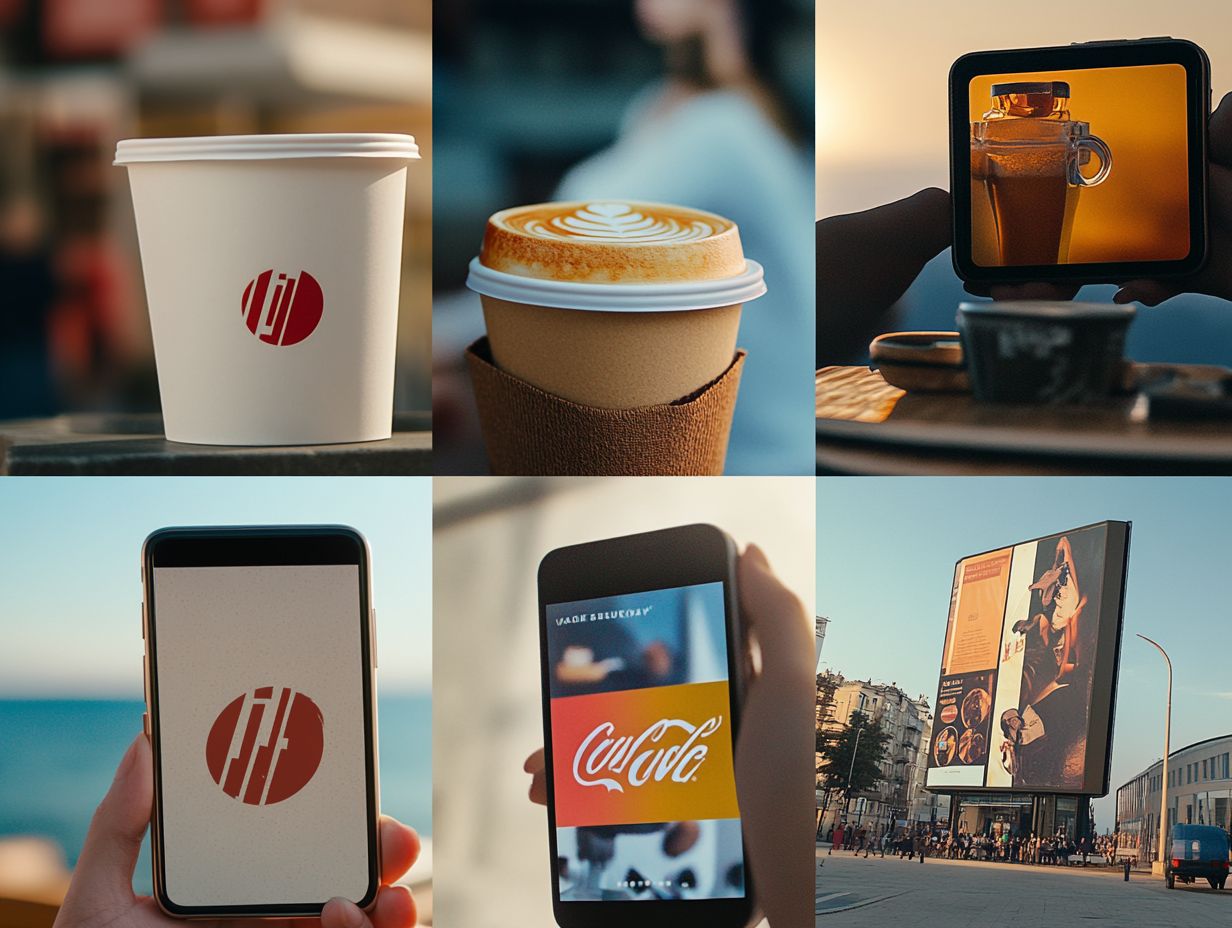5 Innovative Ways to Use Trademarks in Ads
In today s competitive market, leveraging your trademark can transform your advertising strategy!
Discover five creative ways to use your trademark in advertising, including catchy slogans and impactful influencer partnerships. You ll learn the secrets to using visuals effectively, creating compelling calls to action, and developing unique hashtags that resonate.
We ll also explore the legal considerations, ways to measure your impact, and common pitfalls to avoid. This ensures your trademark not only works for you but remains protected!
Get ready to elevate your brand and make a lasting impression!
Contents
- Key Takeaways:
- 1. Create a Catchy Slogan or Tagline Using Your Trademark
- 2. Incorporate Your Trademark into Visuals and Graphics
- 3. Use Your Trademark as a Call to Action
- 4. Partner with Influencers or Celebrities to Promote Your Trademark
- 5. Create a Unique Hashtag Using Your Trademark
- How Can Trademarks Enhance Your Advertising Strategy?
- What Are the Legal Considerations When Using Trademarks in Ads?
- How Can You Measure the Impact of Using Trademarks in Ads?
- What Are Some Successful Examples of Using Trademarks in Ads?
- What Are Some Common Mistakes to Avoid When Using Trademarks in Ads?
- How Can You Protect Your Trademark While Using It in Ads?
Key Takeaways:

Give your brand a voice with a catchy slogan or tagline that features your trademark.
Make your trademark visually appealing by incorporating it into graphics and visuals in your ads.
Use your trademark to grab attention and encourage action now!
1. Create a Catchy Slogan or Tagline Using Your Trademark
Creating a catchy slogan or tagline with your trademark is essential for establishing your brand identity and building customer loyalty. In today s advertising landscape, being memorable can minimize confusion about your products and services.
A well-crafted slogan does more than grab attention; it captures your brand’s values and mission, turning it into a valuable marketing asset.
Coca-Cola s slogan Open Happiness makes you feel refreshed and joyful, creating a strong emotional connection. Similarly, Budweiser s tagline The King of Beers reinforces its status as a premium product, appealing to consumers who value quality.
These examples show how effective slogans resonate with target audiences, integrate into marketing strategies, and navigate trademark law to prevent using someone else’s trademark without permission, safeguarding your brand identity.
2. Incorporate Your Trademark into Visuals and Graphics
Integrating your trademark into visuals is vital for reinforcing your brand identity and creating impactful advertising that resonates with consumers, enhancing brand loyalty.
When done effectively, visuals can evoke powerful emotions that align with your brand. For instance, John Deere’s iconic green and yellow color scheme, paired with rugged imagery, evokes feelings of reliability and hard work.
Similarly, Christian Dior s marketing visuals showcase luxury, with elegant fabrics and graceful models embodying high fashion that appeals to affluent consumers.
Keep in mind the potential legal issues of using trademarks without permission; infringing on these marks can lead to serious complications, undermining your brand s integrity.
3. Use Your Trademark as a Call to Action

Use your trademark to grab attention and encourage action now! Doing so can significantly elevate brand recognition and foster consumer engagement.
The psychological impact of effective calls to action is remarkable. They compel immediate responses from consumers by tapping into their decision-making processes.
Take Avis, for instance. They ve woven their trademark into campaigns that strike an emotional chord, enhancing their market presence.
Hertz shows the strength of a well-aligned brand identity, using it strategically to create clear directives that invite customer action.
These companies must adhere to fair use principles in advertising to avoid trademark infringement, ensuring they respect intellectual property while harnessing their brand influence.
4. Partner with Influencers or Celebrities to Promote Your Trademark
Partnering with influencers or celebrities can significantly enhance brand loyalty. This strategy extends your reach and harnesses their unique connection with audiences across social media platforms.
This choice not only amplifies visibility but also elevates credibility, as consumers tend to trust these public figures. When influencers align themselves with a trademark that resonates with their personal brand, their authentic endorsement can lead to higher engagement and conversion rates.
Make sure you protect your trademark during these collaborations. This safeguards you against potential risks, such as brand tarnishment from misuse or misrepresentation, ensuring your trademark remains a valuable asset and creates a good impression with consumers.
5. Create a Unique Hashtag Using Your Trademark
Creating a unique hashtag using your trademark can significantly enhance your brand identity. It fosters community engagement on social media, positioning it as a crucial aspect of contemporary advertising strategies.
This engagement goes beyond brand recognition; it enables your audience to share their experiences and connect with others who have similar interests.
Take Coca-Cola s #ShareACoke campaign, for example. It encouraged customers to post pictures with personalized bottles, resulting in a treasure trove of user-generated content and lively conversations surrounding the brand.
Similarly, Starbucks #RedCupContest invites customers to showcase their holiday spirit, effectively linking social actions to brand loyalty.
However, tread carefully when promoting hashtags; misleading claims can lead to false advertising, jeopardizing your brand’s reputation and eroding consumer trust.
How Can Trademarks Enhance Your Advertising Strategy?

Incorporating trademarks into your advertising strategy can significantly elevate your brand identity and recognition. By learning how to use trademarks in marketing, you can establish a strong, unmistakable presence in the marketplace while safeguarding your trademark rights from unauthorized use by competitors.
By crafting memorable slogans that encapsulate your brand s essence, you can forge a lasting connection with your audience and encourage them to engage with you repeatedly.
The use of compelling visuals think logos and color schemes that align with your trademark can captivate attention and reinforce your brand messages instantly.
Forming partnerships with other trusted brands amplifies your visibility and credibility, allowing you to tap into established consumer trust.
Ultimately, the effective use of trademarks fosters brand loyalty, ensuring consumers feel a genuine connection amidst the overwhelming choices in today s saturated market.
What Are the Legal Considerations When Using Trademarks in Ads?
Understanding the legal considerations surrounding trademarks in your advertisements is essential for steering clear of trademark infringement (using a trademark without permission) and navigating the complexities of trademark law. Missteps can have serious repercussions, including costly lawsuits and damaging your company s reputation.
The concept of fair use (limited use of trademarks without permission) plays a vital role, allowing certain uses in comparative advertising, where you highlight your products alongside those of competitors. To ensure you choose a strong trademark and understand the nuances of fair use, it’s advisable to check out 5 tips for choosing a strong trademark and consult legal counsel before launching any advertising campaign.
Take, for example, the high-profile dispute that erupted between two tech giants over comparative advertising claims this clash resulted in significant consumer confusion. Such cases underscore the importance of understanding trademark rights to avoid pitfalls that could jeopardize your brand’s value.
How Can You Measure the Impact of Using Trademarks in Ads?
Measuring the impact of using trademarks in your ads requires a keen assessment of brand recognition and consumer response. This provides you with helpful information about the effectiveness of your advertising strategy.
To truly grasp the nuances, it’s vital to examine various metrics, such as engagement rates and brand recall studies. These measurements help you understand how well consumers connect with advertisements that feature trademarks.
Conducting consumer surveys adds depth to your analysis, allowing you to gauge audience sentiment accurately. By examining consumer confusion and any shifts in brand perception that may arise after your campaign, you can refine your marketing initiatives. This ensures that your messages resonate clearly and positively with your target audience.
What Are Some Successful Examples of Using Trademarks in Ads?

Successful examples of using trademarks in advertisements, such as Coca-Cola’s iconic branding and The Energizer Bunny’s enduring presence, illustrate the power of distinctive trademarks in fostering brand loyalty and engaging consumers.
By diving into these remarkable campaigns, you can uncover strategic elements that contribute to their success. For instance, Coca-Cola has effectively used its recognizable logo and color palette to forge a deep emotional connection with consumers during the holiday season. This effectively transforms its brand into a symbol of joy and togetherness.
Similarly, The Energizer Bunny, with its consistent and memorable appearances, has become synonymous with product longevity and reliability. These strategies boost brand visibility and yield tangible results, such as increased sales and market share, showcasing how you can replicate these approaches in your future advertising endeavors.
What Are Some Common Mistakes to Avoid When Using Trademarks in Ads?
Avoiding common pitfalls like false advertising or accidentally infringing on trademark rights is crucial for maintaining your credibility and building consumer trust in your advertising efforts.
You must understand local laws and industry regulations to succeed. Additionally, be aware of how your messaging will resonate with your audience. In marketing, clarity is paramount; steer clear of any ambiguous statements that might mislead consumers.
It s also essential to respect existing trademarks by conducting thorough searches and securing necessary permissions before using recognizable names or logos. By implementing these strategies, you can establish a more trustworthy brand presence while minimizing the risk of legal headaches or reputational damage.
How Can You Protect Your Trademark While Using It in Ads?
Protecting your trademark while using it in advertisements is essential for preserving your brand identity and maintaining your rights. Here are 5 things you didn’t know about trademarks that can help you navigate your marketing efforts effectively.
To accomplish this effectively, consider registering your trademarks with the United States Patent and Trademark Office (USPTO). This registration provides a solid legal framework for your ownership and usage rights.
Consistently monitoring trademark usage in the marketplace is key; it allows you to identify potential infringements early and take timely corrective action. Moreover, consulting with legal experts who specialize in intellectual property law can significantly bolster your protection strategy.
They can guide you through the complexities of trademark rights, ensuring that your unique identity in the market remains intact, ultimately fostering consumer trust and loyalty.
Don’t miss out on the chance to protect your brand! Apply these insights in your marketing efforts today!






